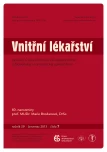-
Medical journals
- Career
Advances in the treatment of chronic lymphocytic leukaemia
Authors: P. Obrtlíková 1; M. Trněný 1,2
Authors‘ workplace: I. interní klinika 1. lékařské fakulty UK a VFN Praha, přednosta prof. MU Dr. Marek Trněný, CSc. 1; Ústav hematologie a krevní transfuze Praha, ředitel prof. MU Dr. Marek Trněný, CSc. 2
Published in: Vnitř Lék 2013; 59(7): 632-634
Category:
Overview
Chronic lymphocytic leukemia (CLL) is the most common forms of leukemia in the western world and is characterized by a highly variable clinical course. Some patients live for many years without treatment, whereas other have disease with rapid progression. The treatment of chronic lymphocytic leukemia has achieved extraordinary progress over the last years with the incorporation of monoclonal antibodies and combined chemoimmunotherapy. Despite these therapeutic successes, CLL is still considered to be an incurable disease. Only the allogenic transplantation is potentially curative but it is feasible only for selected group of younger patients without comorbidities. However, elderly and comorbid patients, who represent the majority of CLL population, are not usually able to undergo intensive treatment. The search for new treatment options is therefore still relevant. This review summerizes the current treatment options and newly tested drugs in CLL.
Key words:
chronic lymphocytic leukemia – treatment – new drugs
Sources
1. Trneny M, Schwarz J, Pavlik T et al. Improving survival in patients with chronic lymphocytic leukemia – population based study. In: ASH Annual Meeting Abstracts 2011.
2. Goldin LR, Björkholm M, Kristinsson SY et al. Elevated risk of chronic lymphocytic leukemia and other indolent non‑Hodgkin’s lymphomas among relatives of patients with chronic lymphocytic leukemia. Haematologica 2009; 94 : 647 – 653.
3. Burger JA. Nurture versus nature: the microenvironment in chronic lymphocytic leukemia. Hematology Am Soc Hematol Educ Program 2011; 2011 : 96 – 103.
4. Hallek M, Cheson BD, Catovsky D et al. Guidelines for the diagnosis and treatment of chronic lymphocytic leukemia: a report from the International Workshop on Chronic Lymphocytic Leukemia updating the National Cancer Institute ‑ Working Group 1996 guidelines. Blood 2008; 111 : 5446 – 5456.
5. Eichhorst BF, Busch R, Stilgenbauer S et al. First‑line therapy with fludarabine compared with chlorambucil does not result in a major benefit for elderly patients with advanced chronic lymphocytic leukemia. Blood 2009; 114 : 3382 – 3391.
6. Hallek M, Fischer K, Fingerle ‑ Rowson G et al. Addition of rituximab to fludarabine and cyclophosphamide in patients with chronic lymphocytic leukaemia: a randomised, open ‑ label, phase 3 trial. Lancet 2010; 376 : 1164 – 1174.
7. Keating MJ, O’Brien S, Albitar M et al. Early results of a chemoimmunotherapy regimen of fludarabine, cyclophosphamide, and rituximab as initial therapy for chronic lymphocytic leukemia. J Clin Oncol 2005; 23 : 4079 – 4088.
8. Obrtlikova P et al. Fludarabine, Cyclophosphamide and Rituximab (FCR) Related Prolonged Cytopenia Is Frequent and Adverse Factor Affecting Survival of Patients with Chronic Lymphocytic Leukemia (CLL). ASH Annual Meeting abstracts 2012; 120 : 1790.
9. Smolej L et al. Low ‑ Dose Fludarabine and Cyclophosphamide Combined with Rituximab In the Treatment of Elderly/ Comorbid Patients with chronic Lymphocytic Leukemia/ Small Lymphocytic Lymphoma (CLL/ SLL): Preliminary Results of Project Q ‑ Lite by Czech CLL Study Group. ASH Annual Meeting Abstracts 2010; 116 : 2466.
10. Coiffier B, Lepretre S, Pedersen LM et al. Safety and efficacy of ofatumumab, a fully human monoclonal anti‑CD20 antibody, in patients with relapsed or refractory B ‑ cell chronic lymphocytic leukemia: a phase 1 – 2 study. Blood 2008; 111 : 1094 – 1100.
Labels
Diabetology Endocrinology Internal medicine
Article was published inInternal Medicine

2013 Issue 7-
All articles in this issue
- Liver disorders in diabetic patients
- Effects of GLP-1 (glucagon‑like peptide‑ 1) on liver
- Digestive tract polyposes
- Neonatal hyperbilirubinemia and molecular mechanisms of jaundice
- Cystic tumors of the pancreas – our experience with diagnostics
- Wilson’s disease
- Effect of liver cirrhosis on pharmacokinetics and pharmacodynamics of drugs
- Hepatic cein catheterisation – selected assessment aspects
- Reactivation of chronic hepatitis B
- Acute pancreatitis – new developments in treatment
- Hepatic involvement in patients with non‑Hodgkin’s lymphoma
- Treatment of chronic hepatitis C virus infection at the beginning of a new era
- Relationship of bilirubin to diseases caused by increased oxidative stress
- Tyrosine kinase inhibitors – major change in the prognosis of chronic myeloid leukaemia
- Multiple myeloma
- Advances in the treatment of chronic lymphocytic leukaemia
- Myelodysplastic syndromes – therapy progress over the last two decades
- Internal Medicine
- Journal archive
- Current issue
- Online only
- About the journal
Most read in this issue- Relationship of bilirubin to diseases caused by increased oxidative stress
- Cystic tumors of the pancreas – our experience with diagnostics
- Liver disorders in diabetic patients
- Acute pancreatitis – new developments in treatment
Login#ADS_BOTTOM_SCRIPTS#Forgotten passwordEnter the email address that you registered with. We will send you instructions on how to set a new password.
- Career

